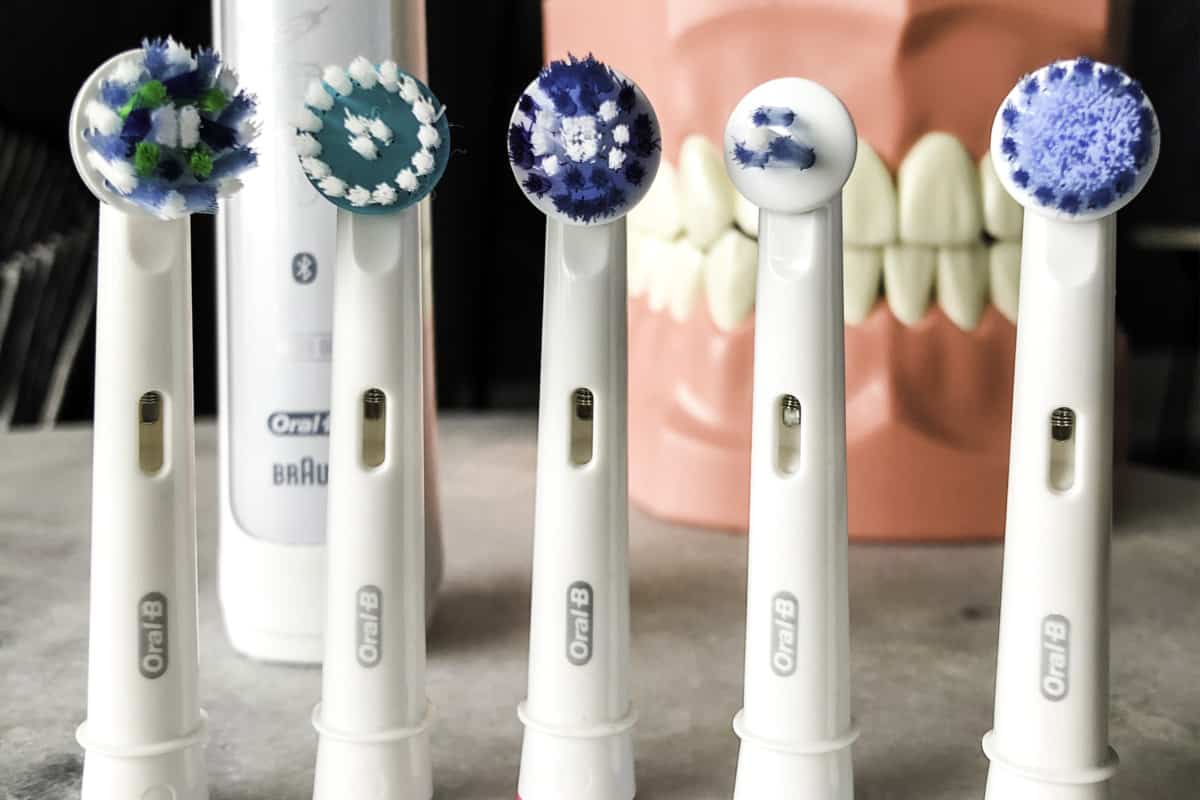
The picture above is another perfect example of how overwhelming the toothbrush aisle can be. With so many different gadgets it can be easy to get lost in it and put us off of even buying anything.
Often we grab what we are used to or what’s on sale and go.
Because we do this, we may be overlooking the brush head that could be more beneficial to us.
Which Oral-B electric toothbrush head is right for you?
The different brush heads that are available for the Oral-B electric toothbrushes are my favourite thing about them (followed closely by the pressure sensor).
are my favourite thing about them (followed closely by the pressure sensor).
Some electric toothbrush brands have a “one size fits all” approach. But we’re all different, with different oral health needs.
All the brush heads for the oral-b electric toothbrushes are universal, being able to interchange from brush to brush.
Furthermore, all the heads are designed with dental professionals to provide the consumer with the best available product for their needs.
The perfect Oral-B brush head for you depends on your oral health condition and your personal wants and needs. The brush heads can be categorized by their use;
- Sensitive gums and teeth/gum recession/root exposure
- Implant and bridge work (or prosthodontics)
- Whitening (removing stains)
- Orthodontics
- Interdental focused (remember it doesn’t replace flossing!)
- Normal mouth with no specific needs
Sensitive gums and teeth/gum recession and root exposure

If you have sensitive or thinning gums, wear on your teeth and/or root exposure you may want to switch to the sensitive brush head. The bristles are softer and will not be as harsh on the tissues. If you are using a brush that has a harder bristle or plastic, it can be potentially damaging to your teeth.
An added bonus tip; the softer the brush bristles the more they can bend under the gumline and clean away more bacteria and food debris!
There is the regular sensitive brush or the Sensi-Ultrathin
or the Sensi-Ultrathin
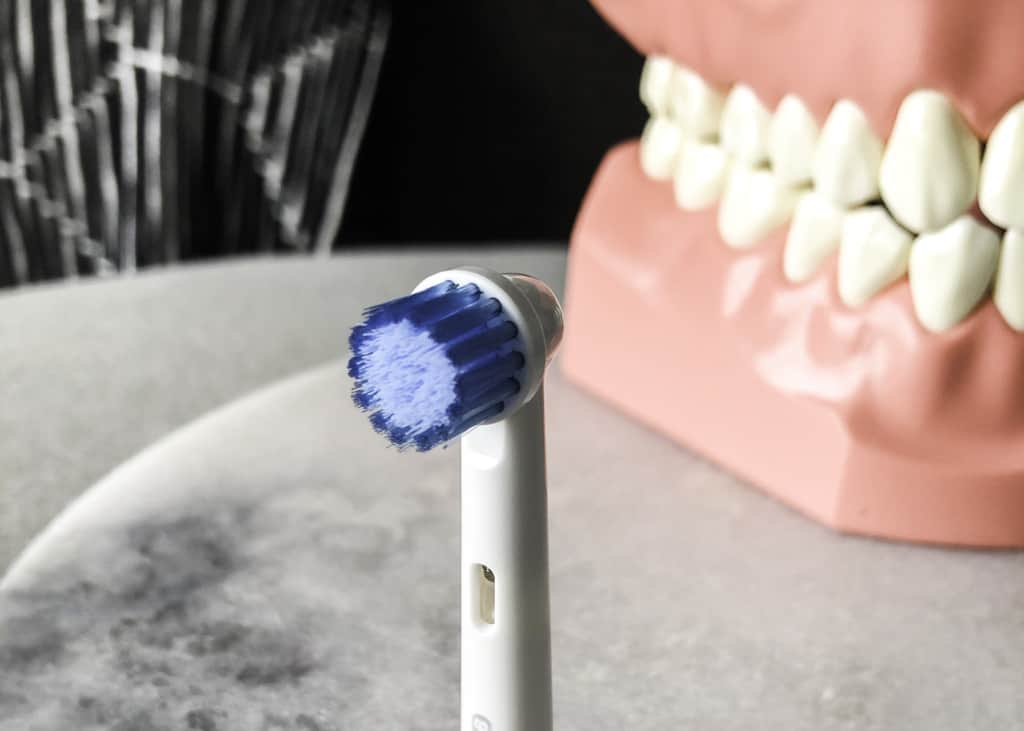
The regular sensitive brush is a great option, with extra soft bristles, however, I do prefer the new Sensi-Ultrathin. The regular sensitive brush head is flat, there is no difference in the height of the bristles or the way they are angled. I find that because of this, the brush won’t reach into the grooves of the teeth or in between the teeth as well as the Sensi-Ultrathin.
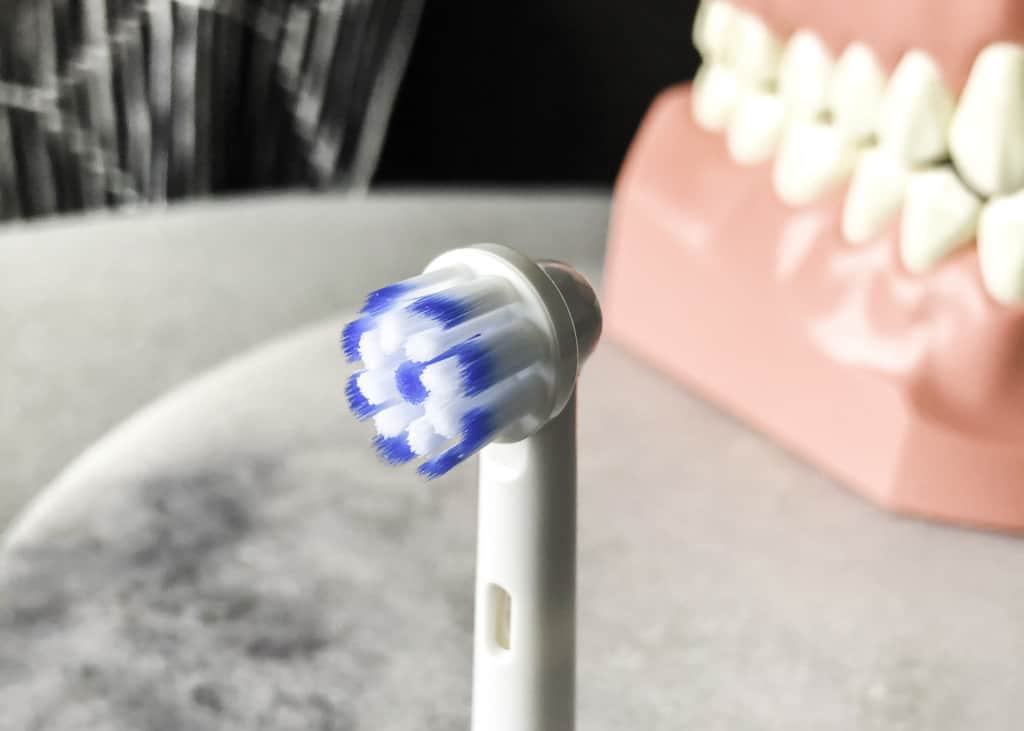
The Sensi-Ultrathin has 8 clusters of bristles around the outer edge, angled in a way that will guide over the teeth and gums to sweep away the plaque.
This brush head is a better option for people who are just starting to use an electric toothbrush. Because the electric brushes move at a fast rate and stimulate the gum tissue more than a manual, they can cause some discomfort when you first start using them.
Using a brush head that is more gentle will make the transition period much more comfortable and make you want to keep on using it.
Implant and bridge
You have invested a lot of money on your mouth and keeping it clean will prolong the longevity of those investments. Implants and bridges can fail, and again, keeping them healthy and gum disease-free is crucial for you to get the most out of your investment.
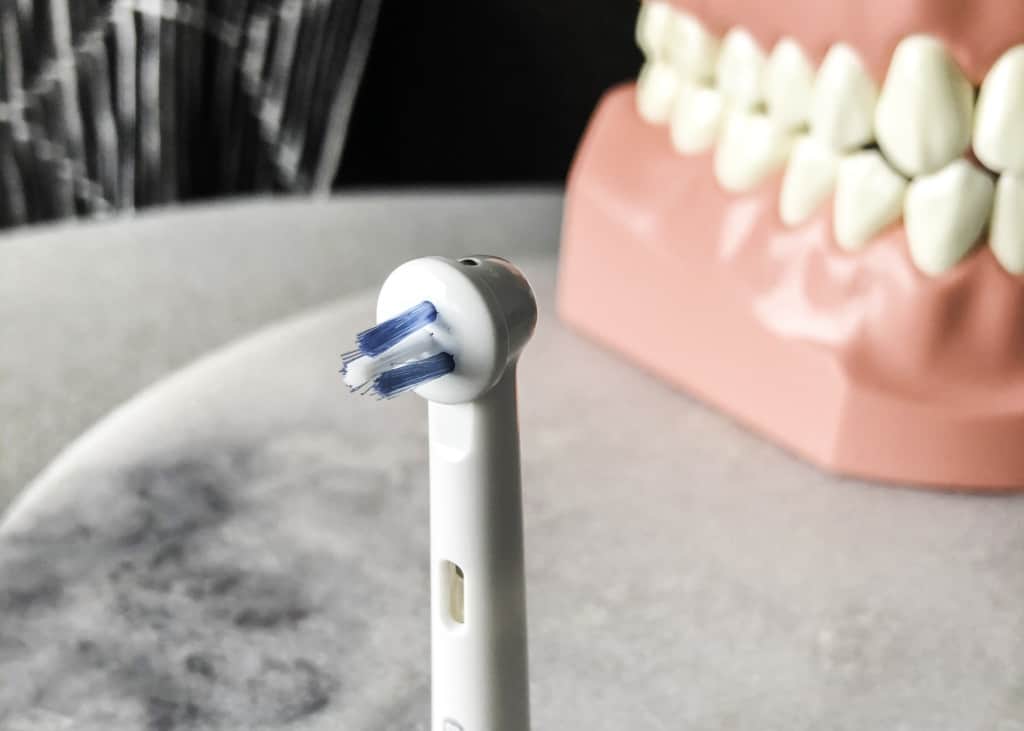
This brush head has been designed to gently clean tight spaces around implants and bridges. Although, please remember this does not replace flossing, as the brush will not get as far under the gumline than floss will.
I especially like this brush for people who have snap-on or all-on-4 dental implant dentures. These implant-supported dentures will have small areas that are hard to clean, including around the implant abutment (the part of the implant that is above the gum).
There is a natural space between the gum and the implant which is susceptible to gum disease, and having a smaller brush head will be able to clean around it very well.
I put together a list of my favourite Bridge and Implant Care Resources to help you take care of your large investment.
to help you take care of your large investment.
Whitening
To clarify, this whitening brush head won’t actually whiten your teeth but rather make your teeth appear more white by removing surface stains. This brush cleans farther in between the teeth compared to some other oral-b brush heads. By cleaning farther between the teeth more plaque and food debris will be removed, preventing tartar (calculus) build-up from forming. The stain will be absorbed into the build-up on your teeth. The less build-up on your teeth means a more white and bright smile!
won’t actually whiten your teeth but rather make your teeth appear more white by removing surface stains. This brush cleans farther in between the teeth compared to some other oral-b brush heads. By cleaning farther between the teeth more plaque and food debris will be removed, preventing tartar (calculus) build-up from forming. The stain will be absorbed into the build-up on your teeth. The less build-up on your teeth means a more white and bright smile!
This brush head also has a rubber cup in the center of the brush which is very similar to the polishing cups us dental hygienists use on your teeth when we prophy polish your teeth. The shape of the cup holds toothpaste and facilitates stain removal.
The main cause of teeth stain is from the food and drink that we consume. Tea, coffee and the dark fruits and vegetables are the biggest culprits, but we can’t cut these out completely, I mean I am definitely never giving up coffee.
The best way to keep your teeth looking white is to prevent the stain in the first place. Here’s how!
Orthodontics (braces)
It is SO difficult to keep your mouth happy and healthy while going through orthodontic treatment… trust me I had braces twice!
The trick to keeping a healthy mouth during this time is finding what tools work best for you and will keep you the most compliant. The floss and floss threaders aren’t going to do much just sitting on the counter not being touched, and if you are only going to make yourself use them once a week, it’s not enough.
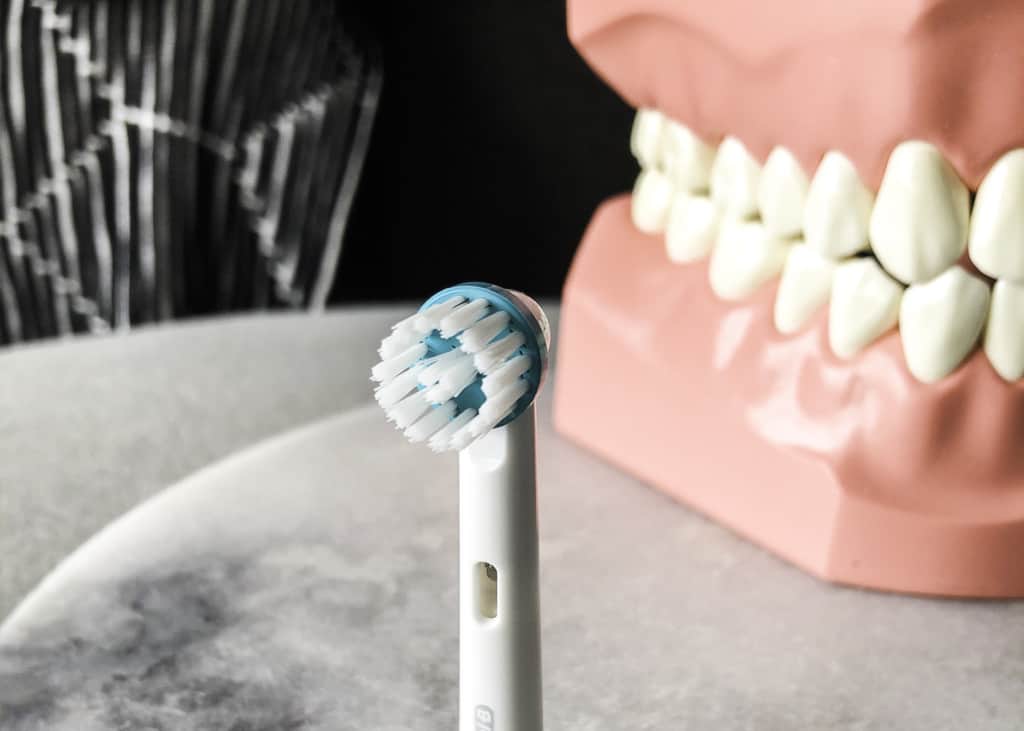
Oral-B designed this orthodontic brush head with space for the bracket. This allows the bristles to move more freely around the wires and brackets, cleaning better underneath them.
with space for the bracket. This allows the bristles to move more freely around the wires and brackets, cleaning better underneath them.
Braces make the perfect home for all those bacteria in your mouth. The small spaces between the wire and bracket can trap food that can be difficult to remove.
When you are brushing with braces you want to first go around your mouth aiming the brush at a 45-degree angle at the gumline. But after that, you want to do the same for the brackets. Go along each bracket, and aim the brush down on every side of the brush
retrieved from; https://www.rdhmag.com/career-profession/students/article/16404128/your-role-before-during-and-after-orthodontic-treatment
If the plaque around the brackets is not removed regularly, the plaque will start to break down your tooth surface, potentially causing cavities. If this happens, you can end up with permanent damage to the enamel and once you have the braces removed you could have permanent white squares around there the brackets used to be.
I put together a list of my favourite tools to take care of your smile while going through orthodontic treatment: My Orthodontic Resources
Interdental focused (doesn’t replace flossing)
This Floss Action brush head is for people who want a better clean between their teeth ontop of their flossing routine. It has longer bristles on the outer ring along with soft plastic “paddles” which can reach farther between the teeth and gums.
is for people who want a better clean between their teeth ontop of their flossing routine. It has longer bristles on the outer ring along with soft plastic “paddles” which can reach farther between the teeth and gums.
I am a huge advocate for compliance, I would rather you use a toothpick than nothing at all. I know people hate to string floss for many reasons and it could even be a lack of range of motion and physical limitations.
If you have issues with string flossing, these aids can help you achieve a healthier smile vs. not flossing at all.
- Waterpik
- Floss sticks/toothpicks
- Ip brushes
- Sulcabrush
- And don’t forget the electric toothbrush!
Electric toothbrushes aren’t just great for people who don’t floss, there are so many other benefits to using them that you probably didn’t even know!
Read Now: 12 Benefits of Using an Electric Toothbrush
Normal mouth with no specific needs
If none of the above special scenarios fit with your needs than a normal Oral-B brush head will be great for you.
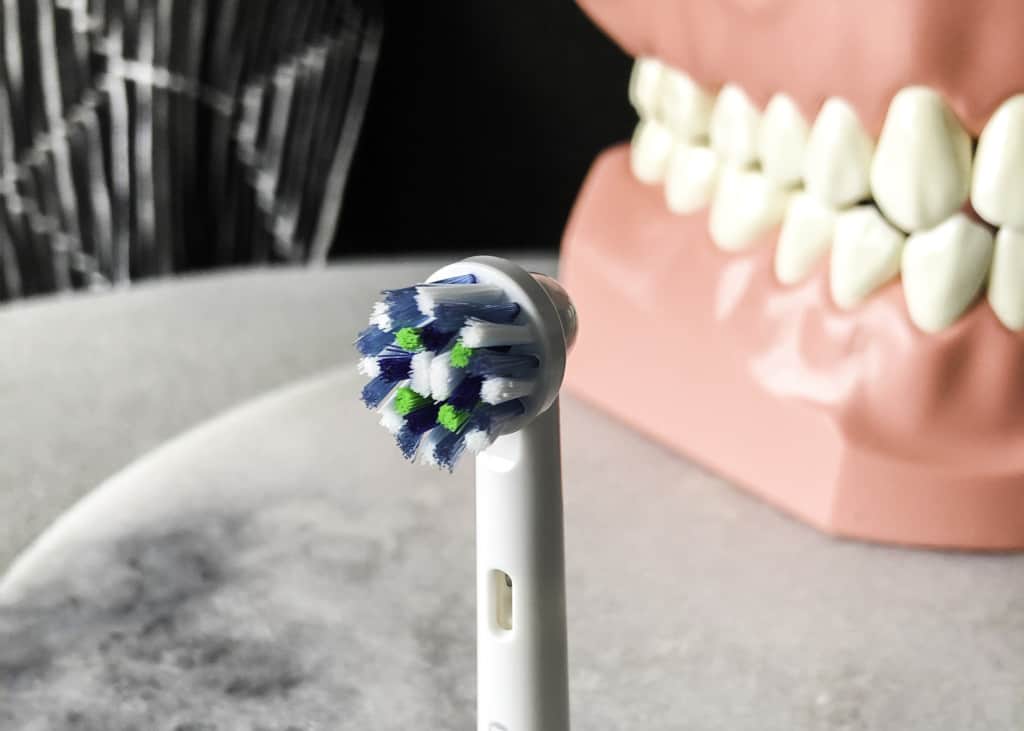
The CrossAction toothbrush head has its bristles angled at 16 degrees to help disrupt and sweep away the plaque on the teeth. It is similar to the Sensi-Ultrathin brush head.
has its bristles angled at 16 degrees to help disrupt and sweep away the plaque on the teeth. It is similar to the Sensi-Ultrathin brush head.
The Precision Clean is a brush head great for beginners. No bells and whistles just focused on providing a superior clean.
is a brush head great for beginners. No bells and whistles just focused on providing a superior clean.
Remember to change your brush head every 3 months!
Changing your brush head every 3 months is important because over time the bristles become worn out and will not be as effective. Think of it as an oil change for your car. If you skipped an oil change you’d be having an issue with your car sooner rather than later.
Keep a keen eye on the brush head though, it could wear out before the 3 months have gone by. This could be due to brushing too hard or an incorrect technique.
Make sure you are using the proper technique when using your Oral-B toothbrush.
Read now: The Correct Way to Use an Oral-B Electric Toothbrush
The amazing thing about Oral-B brush heads is that they come with a built-in indicator on when your brush head really needs to be changed… it’s the bristles! The blue indicator bristles will fade to light blue/white when the toothbrush is worn out.
If you are still wondering which brush head is right for you, don’t be shy to ask your dental professional. They will help guide you in what one will be the best fit for you for your mouths needs.
Happy Brushing
Holly 🙂


